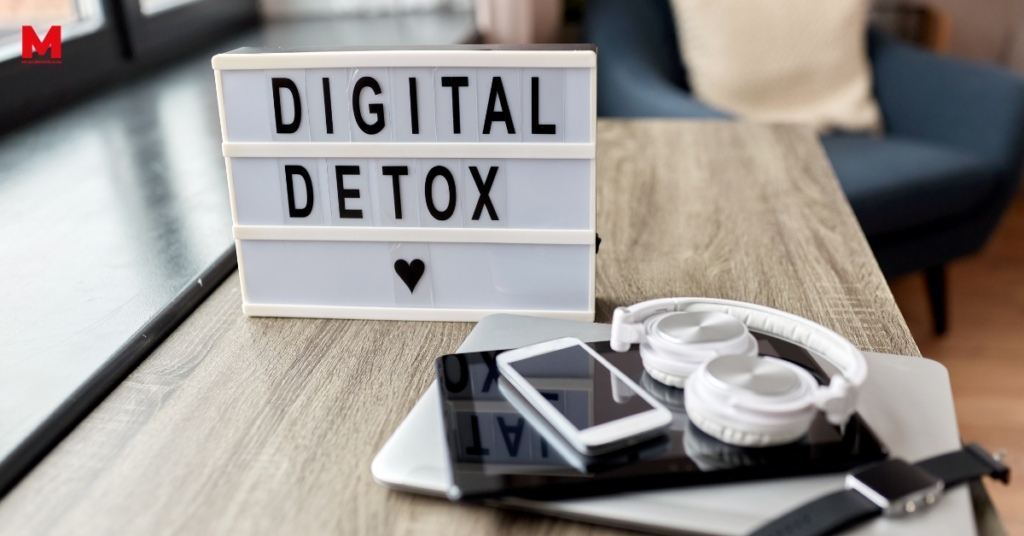Unplugging is more important than ever before. We rely on our digital devices for almost every aspect of our lives, from work to communication and leisure. But too much technology can be unhealthy for our mental health, leading to stress, anxiety, and even depression. Taking the time to unplug and recharge can be an effective way to restore balance in our lives. In this blog post, we’ll explore 7 digital detox strategies that can help you to unplug and recharge your mental wellbeing.
What is a Digital Detox?
A digital detox is the intentional act of disconnecting from technology and digital devices for a period of time to focus on one’s mental wellness and personal growth. In today’s society, we are increasingly reliant on digital technology for work, entertainment, and social connection. However, excessive use of technology can lead to a variety of negative effects on mental health, including anxiety, depression, and addiction.
A digital detox is an opportunity to unplug from these stressors and prioritize mental wellness. This can involve taking a break from social media, email, and other digital platforms to focus on activities such as spending time in nature, reading a book, or engaging in creative pursuits. A successful digital detox requires intentionality and a commitment to self-care. It may feel challenging at first, but the benefits of a digital detox can include improved focus, better sleep, and a greater sense of balance and perspective.
The Importance of Unplugging
With the constant stream of notifications and endless scroll of social media, it’s no wonder that many people are feeling overwhelmed and burned out. However, taking a break from technology can have immense benefits for mental wellness.
Here are some reasons why unplugging is important:
Reduce Stress and Anxiety
- Constant exposure to technology can lead to increased stress and anxiety levels
- Taking a break from screens can help you feel more calm and centered
Improve Sleep Quality
- The blue light emitted by screens can interfere with the body’s natural sleep cycle
- Disconnecting from technology before bedtime can lead to better sleep quality and more restful nights
Increase Productivity
- Technology can be a major distraction, making it difficult to focus on tasks at hand
- By unplugging, you can increase productivity and focus on what’s important
Foster Better Relationships
- Technology can create a false sense of connection, leading to feelings of loneliness and isolation
- Taking time to disconnect and spend quality time with loved ones can strengthen relationships
Overall, unplugging from technology is an important step towards maintaining mental wellness. By taking breaks from screens and developing a healthier relationship with technology, we can reduce stress, improve sleep, increase productivity, and foster better relationships with those around us.
7 Strategies for a Successful Digital Detox
In today’s digital age, taking a break from technology can be incredibly beneficial for our mental wellness. However, the idea of completely unplugging can be daunting and overwhelming. That’s why it’s important to have a plan in place and implement strategies to ensure a successful digital detox. Here are 7 strategies to help you unplug and recharge:
1. Set boundaries:
Establish designated times for device usage and stick to them. Whether it’s avoiding screens an hour before bedtime or setting aside certain hours of the day for digital-free activities, creating boundaries can help you maintain a healthy balance.
2. Create a tech-free zone:
Designate certain areas in your home as tech-free zones, such as the bedroom or dining area. This will allow you to disconnect and fully engage in activities without distractions.
3. Practice mindfulness:
Incorporate mindfulness techniques into your daily routine. Take breaks throughout the day to breathe, meditate, or simply be present in the moment. This will help you cultivate a healthier relationship with technology and reduce dependence on it.
4. Engage in offline activities:
Find activities that bring you joy and fulfillment that don’t involve screens. This could be reading a book, going for a walk in nature, or engaging in a hobby you enjoy. By finding alternative activities to fill your time, you’ll be less tempted to reach for your devices.
5. Set realistic goals:
Start small and gradually increase the duration of your digital detox. Setting realistic goals will increase the chances of success and prevent feelings of failure or frustration.
6. Practice self-care:
Use your digital detox time to focus on self-care activities that nourish your mind, body, and soul. This could include taking a long bath, practicing yoga, or spending quality time with loved ones.
7. Seek support:
It can be helpful to enlist the support of friends or family members who can hold you accountable during your digital detox. Share your goals with them and ask for their support in sticking to your plan.
By implementing these strategies, you’ll be well on your way to experiencing the many benefits of a digital detox. Remember, it’s all about finding a balance and taking time to unplug and recharge for improved mental wellness.
Setting Realistic Goals for Your Digital Detox
When embarking on a digital detox, it’s important to set realistic goals for yourself. This will help you stay motivated and ensure that you have a successful experience. Here are some strategies for setting achievable goals during your digital detox:
- Start Small: Begin by setting small goals that you know you can achieve. For example, you can start by unplugging for an hour each day and gradually increase the duration as you become more comfortable.
- Be Specific: Instead of simply saying you want to unplug, be specific about what you want to achieve during your digital detox. Whether it’s spending more quality time with loved ones or pursuing a hobby, having a clear goal will help you stay focused.
- Set Boundaries: Establish clear boundaries for yourself and communicate them to others. Let your friends, family, and colleagues know when you’ll be offline so they understand and respect your decision.
- Prioritize Activities: Make a list of activities or hobbies you’ve been neglecting due to excessive screen time. Prioritize these activities and set goals for incorporating them into your daily routine.
- Create Accountability: Share your goals with a close friend or family member who can hold you accountable. Having someone check in on your progress can help you stay motivated and committed to your digital detox.
Remember, the purpose of a digital detox is to create a healthier relationship with technology, so it’s important to set realistic goals that align with your individual needs and lifestyle. By taking these steps, you’ll be on your way to a successful digital detox and improved mental wellness.
Overcoming Obstacles During Your Digital Detox
As with any endeavor, it’s natural to face obstacles during your digital detox. Here are some strategies to help you stay on track and overcome these challenges:
1. Identify Triggers:
Pay attention to what makes you reach for your phone or computer. Is it boredom, stress, or a particular app? Once you know your triggers, you can develop healthier coping mechanisms.
2. Find Alternatives:
If you find yourself using your phone to fill a void, try finding alternative activities that bring you joy. Whether it’s going for a walk, practicing mindfulness, or reading a book, there are many ways to find pleasure outside of the digital world.
3. Set Boundaries:
Establish clear boundaries with others about your digital detox. Let them know when you will be unavailable, and ask for their support in staying off your devices.
4. Be Kind to Yourself:
Remember that change takes time and effort. Don’t beat yourself up if you slip up and use your phone or computer. Instead, be gentle with yourself and refocus on your goals.
5. Focus on the Benefits: Keep in mind the benefits of your digital detox, such as improved mental clarity, more meaningful connections with loved ones, and a better quality of life.
By staying mindful of your triggers, finding alternative activities, setting boundaries, being kind to yourself, and focusing on the benefits, you can overcome any obstacles that may arise during your digital detox.
Summary
Unplugging and taking a break from digital devices can greatly improve mental wellness. By following the 7 strategies outlined in this article, such as setting realistic goals and finding alternative activities, you can successfully complete a digital detox and recharge your mental batteries. Overcoming obstacles during the detox may be challenging, but the benefits to your mental health make it worth it. Take the step towards a healthier and happier you by trying out a digital detox today.


